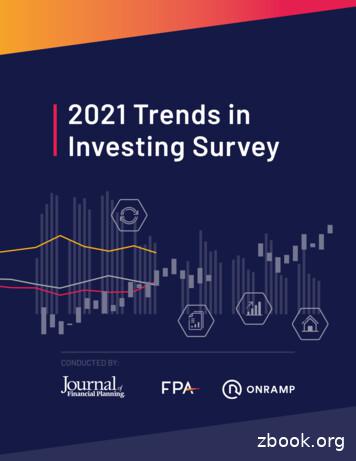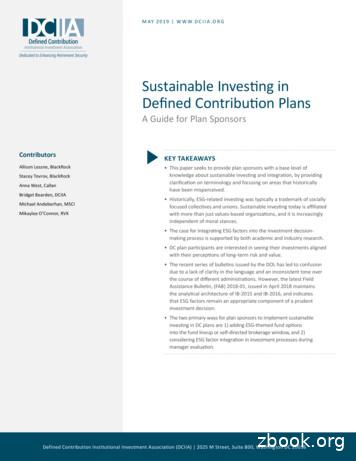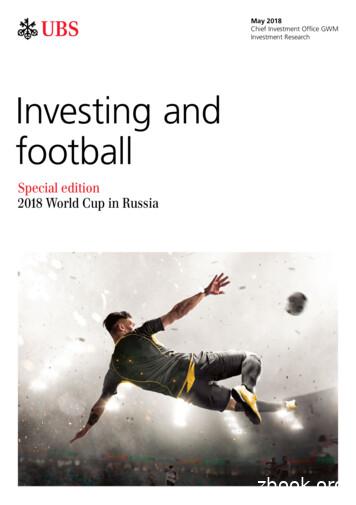A GUIDE TO INVESTING VS. TRADING
A GUIDE TOINVESTINGVS. TRADINGIn this guide, we take a look at the basics of investing andtrading and explain how the two financial strategies differ
THE TERMS‘INVESTING’ AND‘TRADING’ AREOFTEN USEDINTERCHANGEABLY.However, there are keydifferences between thetwo financial strategies.The goal of investing isgenerally to build wealthover the medium to longterm. By contrast, thegoal of trading is togenerate profits in theshort-term.In this guide, we take alook at the basics ofinvesting and trading andexplain how the twofinancial strategies differ.A GUIDE TO INVESTING VS. TRADINGCONTENTSPG02 What is investing?PG03 What is trading?PG01 What is social trading?PG06PG10 Investing vs trading:which is better?PG10 Summary: Investing vstradingPG11 GlossaryInvesting vs trading: KeydifferencesPG 01
WHAT IS INVESTING?Investing is a longer-term ‘buy-and-hold’ strategy.Investors will often hold assets for years, or even decades, with the aim of generating profits from rising assetprices and any income generated from the assets over time.An investor’s exact time horizon (the length of time that the investor expects to invest for) will depend on theirfinancial objectives. For example, someone who is investing for retirement may have a time horizon of 20 yearsor longer. Someone who is investing to build up a house deposit, on the other hand, may have a time horizon offive years.A fundamental principle of investing is that the higher the potential return of an investment, the higher the riskof that investment. This is known as the ‘risk-return trade-off’. Risk refers to the chance that an investment'sactual returns will differ from its expected returns.RETURNRISK-RETURN TRADE-OFFLow RiskLow ReturnHigher RiskHigh Potential ReturnSTANDARD DEVIATION (OR RISK)The longer an investor’s time horizon, the more they can focus on higher-growth, higher risk investments. Thisis because they have more time to ride out market volatility. An investor with a shorter time horizon will need tobe more conservative with their investment choices otherwise they run the risk of not achieving their financialgoals.Most investors are comfortable with the fact that financial markets tend to rise and fall in the short term. As aresult, they will often ride out periods of underperformance with the expectation that asset prices willeventually rebound and any short-term losses will be recovered.A GUIDE TO INVESTING VS. TRADINGPG 02
INVESTING STYLESThere are two main styles of investing. These are:ACTIVE INVESTING:In this approach, investors actively buy and sell securities for their portfolio with the aim ofoutperforming an investment benchmark index over time. An active stock market investor, forexample, might buy 30 individual stocks with the aim of outperforming the S&P 500 index (astock market index that is composed of 500 large US companies).PASSIVE INVESTING:The goal of passive investing is simply to match the performance of a market or benchmarkindex over time. In this approach, investors do not pick individual securities for their portfolio.Instead, they invest in benchmark-based funds, such as exchange-traded funds (ETFs) andindex funds, that aim to track the performance of a market.WHAT IS TRADING?Compared to investing, trading is a more active, short-term-focused strategy.Traders tend to hold assets for a much shorter period of time than investors, often buying and selling securitieswithin weeks, days, or even hours, with the aim of profiting from short-term price movements.Whereas investors mainly seek to profit from rising asset prices, traders look to profit from both rising andfalling asset prices. Instead of focusing on an asset’s long-term growth prospects like investors do, tradersfocus on which direction the asset’s price is likely to head in next and try to profit from that price movement.While investors often ride out periods of underperformance, traders are more likely to use ‘stop-loss’ orders toautomatically close out losing trades at a predetermined price level. This helps to protect trading capital.Compared to investing, trading generally requires more time commitment. Whereas an investor can buy a stockor fund and forget about it, a trader needs to be constantly monitoring market developments.A GUIDE TO INVESTING VS. TRADINGPG 03
TRADING STYLESThere are a number of different tradingstyles that traders pursue. These include:SCALPING:This is a trading strategy that aims to capture small profits, repeatedly. It involves holding aposition for a very short amount of time – perhaps just a few minutes or even less. Pleasenote that this type of trading is not allowed on eToro.DAY TRADING:This approach to trading involves opening and closing positions within a single day. Closing atrade before the market closes reduces the risks of receiving unfavourable news overnight.POSITION TRADING:The goal of position trading is to profit from dominant price trends. A trend occurs when anasset’s price moves in one direction for an extended period of time.SWING TRADING:The aim of swing trading is to focus on larger price movements, rather than identifying thestart and finish of a price trend. In this strategy, positions may be held for days to weeks.WHAT IS SOCIAL TRADING?Social trading is an innovative form of trading unique to eToro that enables individuals toobserve the trading strategies of their peers or more experienced traders, and potentiallyreplicate these strategies.One of the most prominent developments in the financial industry in recent years, it brings traders from differentbackgrounds together, and allows them to collaborate and copy each other’s trades.A GUIDE TO INVESTING VS. TRADINGPG 04
SOCIAL TRADING OFFERS ANUMBER OF BENEFITS:It allows those with limited financial knowledge to leverage the expertise of moreexperienced traders. Beginners can interact with talented or experienced traders andlearn how to analyse the markets and create profitable strategies.It can save traders an enormous amount of research time because everyoneshares information.It enables traders to potentially improve their performance by workingtogether and sharing ideas.It can be used across a wide range of different asset classes including stocks, ETFs,currencies, commodities, and cryptocurrencies.ETORO’SCOPYTRADERFEATURE:A powerful formof social tradingeToro’s award-winning CopyTrader technology takes the social trading concept one step further by enablingindividuals to automatically replicate the strategies of top-performing traders in real time.With CopyTrader, anyone can trade like a top trader. Whether you’re a beginner learning the basics of trading, anexpert that is impressed with another trader’s track record, or someone who simply lacks the time to researchand monitor the financial markets, CopyTrader can help you trade more effectively.CopyTrader is easy to use: simply choose the traders you wish to copy, decide on the amount of money you wantto trade, and copy everything they do automatically, and in real-time, with one click of a button. What’s more,there is no cost to access this service.A GUIDE TO INVESTING VS. TRADINGPG 05
INVESTING VS TRADING: KEY DIFFERENCESAside from the fact that investing is morelong-term focused while trading is moreshort-term focused, there are plenty of otherdifferences between the two strategies.Here’s a look at three key differencesbetween investing and trading.FINANCIAL MARKETSThe main asset class that investors focus on is stocks. Stocks, or ‘shares’ as they are often called, areinvestments that represent ownership in a company.Investing in stocks can be a great way to grow your wealth over time. Historically, stocks have delivered excellentreturns to investors over the long term.For example, since theinception of the S&P 500index in 1926, it has risenby around 10% per year onaverage.This is a much higherreturn than the returnsgenerated by other assetssuch as bonds and cashsavings.Some investors like to pick individual stocks (such as Apple, Amazon, and Microsoft) themselves. Others preferto invest in stocks through funds and ETFs that provide broad exposure to the stock market. At eToro, you caninvest in both stocks and ETFs commission-free.Investors also often add other assets to their portfolios in an effort to enhance their returns and lower theirportfolio risk. For example, an investor might own a selection of stocks and ETFs, as well as some commoditiessuch as gold and silver, and some cryptoassets such as Bitcoin and Ethereum.Compared to investors, traders focus on a wider range of asset classes. For example, there are traders thatfocus on stocks, indices, currencies, commodities, and cryptoassets. Generally speaking, traders tend to prefermore volatile asset classes as it’s volatility that creates trading opportunities.A GUIDE TO INVESTING VS. TRADINGPG 06
YOU CAN TRADE A WIDE RANGE OF ASSET CLASSES, YPTOASSETSWhereas investors usually buy assets outright, traders often use financial instruments such as Contracts ForDifference (CFDs) to gain exposure to a certain asset class or security.CFDs are financial instruments that enable traders to profit from an asset’s price movements without actuallyowning the asset.Most notably, they enable traders to trade in both directions (i.e. profit from both upward and downward pricemovements). They also enable traders to use leverage to control a larger amount of money than they havedeposited on the trade.For example, with X2 leverage, a trader can control 5,000 worth of an asset with a deposit of just 2,500. WithX10 leverage, they can control 5,000 with a deposit of just 500. The advantage of using leverage is that it canincrease your profits. However, leverage can also magnify your losses so it’s important to understand the risks.A GUIDE TO INVESTING VS. TRADINGPG 07
RESEARCH AND ANALYSISAnother difference between investors and traders is the way they research their markets and look foropportunities.Typically, investors focus on fundamental analysis.This type of analysis involves looking at all available information in relation to an asset in order to decidewhether to buy or sell that asset.For example, in the case of a stock, an investor might look at the company’s recent revenue and profit growth, itsbalance sheet, the threat of competitors, and the economic backdrop in order to determine whether the stock isworth buying.Traders, on the other hand, tend to focus more on technical analysis.In this type of analysis, traders examine price charts and analyse trends, patterns, and indicators in an effort topredict an asset’s future price movements. The idea behind technical analysis is that historical price movementscan be used to predict future price movements.THREE POPULAR TECHNICALANALYSIS STRATEGIES INCLUDE:TREND TRADING:This strategy aims to generate profits by analysing an asset’s price trend. Once a trader hasidentified the trend, it may be possible to profit from it by trading in the same direction as the trend.SUPPORT AND RESISTANCE TRADING:This strategy aims to generate profits by identifying an asset’s support and resistance levels.Support is the level on the chart where the asset’s price finds it difficult to fall below. Resistanceis the level where the asset’s price finds it difficult to go above. Once these areas have beenidentified, it may be possible to profit by placing trades at the area where the asset’s price islikely to reverse.BREAKOUT TRADING:This strategy aims to generate profits by identifying assets that have broken throughestablished support or resistance levels. Breakouts can be strong signals, especially whenconfirmed by other technical analysis indicators.A GUIDE TO INVESTING VS. TRADINGPG 08
RISKS AND RISK MANAGEMENTInvesting and trading also have their own unique risks.This means that investors and traders need to manage risk in different ways.THE MAIN RISKS THAT INVESTORS FACE ARE:MARKET RISK:This is the risk that a whole market declines in value.SPECIFIC RISK:This is the risk that a specific asset such as a stock or cryptoassetdeclines in valueInvestors can reduce these risks by diversifying their portfolios. This is the process of spreading money out overmany different investments so that you're not overexposed to one asset or security.A portfolio that has exposure to a wide range of investments, such as many different stocks, a handful of ETFs,some bonds, commodities such as gold and silver, and some cryptoassets will have a much lower overall riskthan a portfolio that simply contains one stock or cryptoasset.THE MAIN RISKS THAT TRADERS FACE ARE:VOLATILITY RISK:This is the risk associated with short-term price fluctuations.LEVERAGE RISK:This is the risk associated with using leverage. While leverage canincrease your profits, it can also magnify losses.RISK MANAGEMENT STRATEGIES FOR TRADERS INCLUDE:Determiningthe optimalposition sizeA GUIDE TO INVESTING VS. TRADINGSetting stoplosses tominimise lossesAvoidingexcessive useof leveragePG 09
INVESTING VS TRADING: WHICH IS BETTER?Both investing and trading havetheir advantages anddisadvantages.Your financial objectivesYour risk toleranceOne strategy is not better thanthe other. Both have proven to besuccessful ways of profiting fromthe world’s financial markets.Your understanding of a particular market or asset classThe amount of time you’re willing to dedicate towardsresearch and monitoring your holdingsUltimately, which strategy issuited to you will depend on avariety of factors including:The amount of capital you have to get startedSUMMARY: INVESTING VS TRADINGThe differences between investing and trading are summarised in the table below.INVESTINGTRADINGTIMEFRAMEMEDIUM TO LONG TERMSHORT TERMPROFITSFROM RISING ASSET PRICES ANDINCOME GENERATED BY ASSETSFROM RISING ASSET PRICES ANDFALLING ASSET PRICESMAIN ASSET CLASSESSTOCKSSTOCKS, CURRENCIES,CRYPTOASSETS, COMMODITIESINSTRUMENTSSTOCKS, ETFS, FUNDSSTOCKS, CRYPTOASSETS, CFDSRESEARCH AND ANALYSISFUNDAMENTAL ANALYSISTECHNICAL ANALYSISTIME COMMITMENTLOWHIGHRISKSMARKET RISK, SPECIFIC RISKVOLATILITY RISK, LEVERAGE RISKCAPITAL REQUIREDFULL AMOUNT OF TRADESMALLER DEPOSIT IF USING LEVERAGETIP: If you want to learn more about how to trade using technical analysis please visitthe eToro Trading School homepage where you can register for a free courseA GUIDE TO INVESTING VS. TRADINGPG 10
GLOSSARYCONTRACT FORDIFFERENCE (CFD)CRYPTOASSETDIVERSIFICATIONA financial instrument that enables you to profit from theprice movements of a security without actually owningthe underlying securityA cryptographically-secured digital asset that can betransferred, stored, and traded electronicallySpreading your money out over many differentinvestments to lower portfolio riskEXCHANGE-TRADED FUND(ETF)An investment fund that aims to track a particularmarket or indexFUNDAMENTAL ANALYSISA form of analysis that involves looking at all availableinformation in relation to an assetGOING LONGBuying a securityGOING SHORTSelling a securityLEVERAGEMARKET RISKRISKRISK MANAGEMENTSPECIFIC RISKSTOCKSTECHNICAL ANALYSISTIME HORIZONA GUIDE TO INVESTING VS. TRADINGUsing capital borrowed from a broker when opening aposition to increase the potential return of aninvestmentThe risk that the whole stock market fallsThe amount of capital exposed on any single tradeFocusing on risk when trading in order to minimiselossesThe risks associated with a particular assetInvestments that represent ownership in a companyA form of analysis that focuses on price chart trends,patterns, and indicatorsThe length of time that an investor expects to invest forPG 11
eToro is a multi-asset platform which offers both investing in stocks and cryptoassets, as well as trading CFDs.CFDs are complex instruments and come with a high risk of losing money rapidly due to leverage. 75% of retailinvestor accounts lose money when trading CFDs with this provider. You should consider whether youunderstand how CFDs work, and whether you can afford to take the high risk of losing your moneyThis information is for educational purposes only and should not be taken as investment advice, personalrecommendation, or an offer of, or solicitation to buy or sell, any financial instruments. This material has beenprepared without having regard to any particular investment objectives or financial situation and has not beenprepared in accordance with the legal and regulatory requirements to promote independent research. Anyreferences to past performance of a financial instrument, index or a packaged investment product are not, andshould not be taken as a reliable indicator of future results. eToro makes no representation and assumes noliability as to the accuracy or completeness of the content of this guide. Make sure you understand the risksinvolved in trading before committing any capital. Never risk more than you are prepared to lose.Guide accurate as of July 2020A GUIDE TO INVESTING VS. TRADINGPG 12
In this guide, we take a look at the basics of investing and trading and explain how the two financial strategies differ. A GUIDE TO INVESTING VS. TRADING PG 01 PG 02 PG 03 PG 01 . Instead, they invest in benchmark-based funds, such as exchange-traded funds (ETFs) and in
Impact investing is a growing area of interest for investors. Impact investing is defined as investing made with the explicit intent to generate positive, measurable social and/or environmental effects in addition to a financial return. According to the Global Impact Investing Network, the impact investing universe represented more
on investing in companies whose products and services are inherently impactful. Ə Impact investing: Coined by the Rockefeller Foundation in 2007, impact investing describes sustainable investing strategies with the intention to deliver measurable impact. A key element of impact investing is investor contribution or additionality. This is
3.2 Investing in adopting and implementing accessibility standards 22 3.3 Investing in a disability-inclusive procurement approach 24 3.4 Investing in development and employment of access audits 26 Chapter 4: Drivers for and added value of investing in accessibility 29 4.1 Demographic factors driving the need for investing in accessibility 30
Your Brokerage Relationship with TIS 1. Available Investment Options 2. Full-Service Brokerage Relationships 3. Self-Directed Brokerage Relationships 4. Investing in Mutual Funds 5. Investing in Annuities 6. Investing in 529 Plans 7. Investing in Unit Investment Trusts 8. Cash Sweep Services B. Other Products and Conflicts of Interest
The Global Impact Investing Network (GIIN) is the global champion of impact investing, dedicated to increasing the scale and effectiveness of impact investing around the world. The GIIN builds critical infrastructure and supports activities, education, and research that help accelerate the development of a coherent impact investing industry.
Investing in ESG/socially responsible investing 39% Investing in marijuana or cannabis stocks/companies 34% 27% Effects of tax reform on their portfolio 27% 49% Investing in cryptocurrencies 17% 49% Direct indexing N/A 4%** 2021 Trends in nvesting Survey 11 Taking Another Look at Asset Allocation
II. SuT SaINablE INVESTING FuNdamENTalS Clarification: Many terms are used in the sustainable investing discussion. In this paper, we use "sustainable investing" as an umbrella term and distinguish ESG integration from ESG-themed funds. A glossary of terms is provided on page 7. Sustainable investing is a framework for investors to examine
Investing and football Investing and football 8 Investing in emerging marets e cial edition- Investing in emerging marets Special edition- 9 -67.7 C The roughly 500 residents of Oymyakon occupy the coldest inhabited place on the planet, where the temperature dropped to -67.7 C at its nadir in 1933. 29% Russia's citizens hold a high























